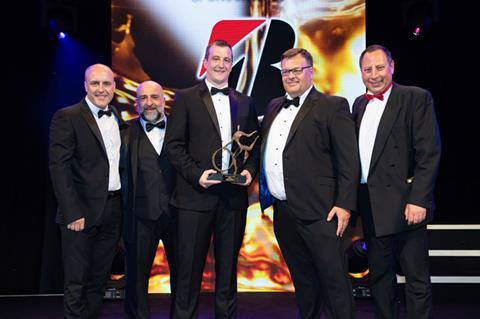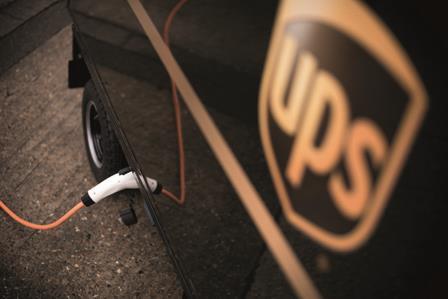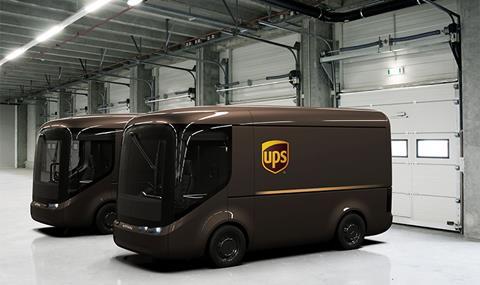
In an industry striving to meet environmental targets, UPS stands out for taking on the challenge of charging electric vehicles – and overcoming it.
The transition to electric vehicles (EVs) by haulage fleets comes with significant challenges, not least how you go about charging them all up. The move by UPS to EVs goes back a few years and, according to the company, was prompted by risk mitigation and a need to address London’s poor air quality.
But in order to meet emissions goals and electrify its fleet at its central depot in Camden, it needed to find a way of accommodating charging on a commercial scale.
The solution, developed in collaboration with UK Power Networks and Cross River Partnership, removes the need for an expensive upgrade to the power supply grid in order to simultaneously recharge 170 vehicles overnight – and the initiative won it the Best Use of Technology Award at the Motor Transport Awards 2019.
Artificial intelligence
SMART grid is an operating system that charges its EV fleet via control algorithms that respond to network grid capacity and the use of artificial intelligence (AI).
UPS says it evaluated different technologies and assessed various smart-charging options and came to the conclusion that a combination of Active Network Management and Energy Storage Systems, along with a high-speed power meter and smart charge posts, could all work together to intelligently monitor energy demand.
Luke Wake, UPS international director of automotive engineering, says: “What typically happens with a conventional vehicle grid is there isn’t any intelligence in the network. Our vehicles all return somewhere between 6pm and 7pm to be put on charge.You run the risk of going over the peak threshold and it can trip.”
Not so with SMART grid. Instead of an entire fleet simultaneously being charged on maximum power at the start, a proportion are prioritised and placed on peak power.
AI and algorithms are then relied upon so that the power demand for individual vehicles is monitored and altered as necessary, dropping from 22kW at the start of the evening to 5kW as the night draws on and all the fleet’s batteries continue to be charged up.
“Let’s say the vehicles all have to be despatched at 7am and it’s now 8pm,” explains Wake. “SMART grid calculates the most efficient way to charge all the vehicles so they can all go out – but they don’t go above the threshold.
“Operationally nothing has changed, but the technology has done it all in the background with no impact on the operation.”
It’s difficult to overstate the importance of SMART grid. Research carried out by UPS prior to collaborating on a solution found there are three primary barriers to EV uptake among large companies: prohibitive initial purchase price, a lack of product availability and a lack of available charging infrastructure.
By demonstrating it has overcome a concern held by 44% of companies surveyed and preventing them from making the leap to EV, UPS has blazed a trail.
“We would have invested in a substation with a further upgrade, but it’s also about a broader strategy,” says Wake.
“As UPS deploys more electric vehicles there’s also a trend that society will deploy electric vehicles.

“National Grid needs a more intelligent approach to how you balance that. It makes more sense from an energy consumption point of view to balance that grid.”
The bottom line is that SMART grid enables UPS to increase its electric vehicle fleet without upgrading the network connection.
It says there has been no solution before this that has allowed commercial fleets to scale up their EVs, and it could mark a major turning point in their deployment worldwide.
However, it’s important to point out that SMART grid is not a one-size-fits-all solution. Wake concedes it was bespoke to its operation in one part of London and if large fleets are going to transition to EVs then it’s likely that there will be a range of solutions, perhaps working along a similar theme.
When considering the deployment of the SMART grid at other UPS depots, Wake explains the importance of looking at each building on a case-by-case basis.
“Different buildings, often by luck or history, have completely different power available in them. What may be possible in one building for 10 vehicles may allow 100 in another.”
UPS emissions goals
UPS has set itself a range of ambitious targets to reduce its environmental impact over the next six years, which include ramping up the number of clean fleet vehicles it runs.
While the growth of e-commerce drives the need for increased capacity and fleet expansion, the company says it intends to reduce absolute greenhouse gas emissions by 12% across its global ground operations by 2025 and it has identified renewable energy as critical to hitting this goal.
In order to achieve this, it has established three targets to accelerate the use of renewables. These are: to source 25% of total electricity needs from renewable sources by 2025; to source 40% of ground fuel from low carbon or alternative fuels by 2025; and to ensure a quarter of its global annual vehicle purchases are an alternative fuel or advanced technology vehicle solution by 2020.
Its Camden depot is a testbed for its EV strategy, but Luke Wake explains it solves more than one obstacle: “It’s one thing to have electric vehicles, but you have to combine that with having vehicles that work within the infrastructure.
“With this SMART grid, as more and more [electric] vehicles are being used, we can take this learning and apply it to other buildings so that we can use as many vehicles [as possible] within that constraint.
“We can continue to scale those vehicles and that’s really important for our broad commercial strategy.”

A capital idea
When UPS first started looking at its commercial vehicles and the potential for electrification at its Camden site, it could see that its package delivery fleet showed the most potential.
The parcel firm divides its fleet into two, Package deliveries – to businesses and homes – works on a ‘return to base’ basis and typically relies on 7.5-tonne purpose-built vehicles.
The other side is its HGV hub-to-hub logistics division, which runs through the night.
“Typically, the package fleet operates throughout the day and then returns to the depot and loads or unloads,” explains Luke Wake.
“This impacts on the charging strategy we need to deploy.”
These fleet vehicles are parked up in the north London depot overnight and so the charging regime is obviously constrained within a time window.
Before SMART grid was introduced, UPS found that it was reaching power thresholds as it gradually increased the number of EVs on the fleet and this limited the number it could run.
“In our night operation, we run a belt system to move packages around the building and, combined with the charging of electric vehicles, this creates a peak power demand that, unmanaged, could trip the infrastructure,” he adds.
This is in contrast to the building’s power needs during the day, which are normally low as its fleet is out in operation and employees’ electricity needs are not significant.
In 2008, it had 10 electric vehicles out of a fleet size of 200, but as the proportion increased over the following decade, so did the demand on the network.
SMART grid solves this consumption conundrum, although UPS had to run a simulation to ensure it was capable of providing its nocturnal power needs before the system was fully launched: “It was such an innovative project that didn’t really exist before,” says Wake. “There was no base to compare it to.”











